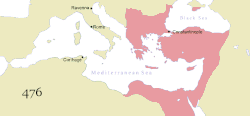Twenty Years' Anarchy
Roman Empire Βασιλεία Ῥωμαίων | |||||||||
|---|---|---|---|---|---|---|---|---|---|
| 695–717 | |||||||||
 The Byzantine Empire by the end of the Twenty Years' Anarchy in 717 AD. | |||||||||
| Capital | Constantinople | ||||||||
| Common languages | Greek | ||||||||
| Religion | Chalcedonian Christianity | ||||||||
| Government | Monarchy | ||||||||
| Emperor | |||||||||
• 695–698 | Leontios | ||||||||
• 698–705 | Tiberios III | ||||||||
• 705–711 | Justinian II | ||||||||
• 711–713 | Philippikos Bardanes | ||||||||
• 713–715 | Anastasios II | ||||||||
• 715–717 | Theodosios III | ||||||||
| History | |||||||||
• First deposition of Justinian II | 695 | ||||||||
• Deposition of Theodosius III | 717 | ||||||||
| |||||||||
| History of the Byzantine Empire |
|---|
 |
| Preceding |
| Early period (330–717) |
| Middle period (717–1204) |
| Late period (1204–1453) |
| Timeline |
| By topic |
|
|
The Twenty Years' Anarchy is a historiographic term used by some modern scholars[1][2][3] for the period of acute internal instability in the Byzantine Empire marked by the rapid succession of several emperors to the throne between the first deposition of Justinian II in 695 and the ascent of Leo III the Isaurian to the throne in 717, marking the beginning of the Isaurian dynasty.
Justinian II and the usurpers, 685–711
| Twenty Years' Anarchy | ||
|---|---|---|
| Chronology | ||
|
||
| Succession | ||
|
||
Justinian II (685–711) set in motion a chain of events by embarking on a despotic and increasingly violent course. His policies met with considerable opposition, eventually provoking a rebellion led by Leontios (695–698) in 695, which deposed and exiled him, precipitating a prolonged period of instability and anarchy, with seven emperors in twenty-two years.[3]
Leontios was popular at first, though the loss of Carthage soon ruined his reputation. John the Patrician led a navy to Carthage, losing in 698. The army feared Leontios, in the same year he was overthrown by Tiberios III (698–705). Tiberios managed to bolster the eastern frontier and reinforced the defenses of Constantinople, but meanwhile Justinian was conspiring to make a comeback and after forming an alliance with the Bulgars succeeded in taking Constantinople and executing Tiberios.
Justinian then continued to reign for a further six years (705–711). His treatment of Tiberios and his supporters had been brutal and he continued to rule in a manner that was despotic and cruel. He lost the ground regained by Tiberios in the east, and imposed his views on the Pope. However, before long he faced a rebellion led by Philippikos Bardanes (711–713). Justinian was captured and executed as was his son and co-emperor, Tiberius (706–711), thus extinguishing the Heraclian line. Justinian had taken the Byzantine empire yet further from its origins. He effectively abolished the historical role of Consul, merging it with Emperor, thus strengthening the Emperors' constitutional position as absolute monarch.
Philippikos Bardanes, 711–713
Philippikos' rebellion extended beyond politics to religion, deposing the Patriarch Cyrus, reestablishing Monothelitism and overturning the Sixth Ecumenical Council, which in turn alienated the empire from Rome. Militarily the Bulgars reached the walls of Constantinople, and moving troops to defend the capital allowed the Arabs to make incursions in the east. His reign ended abruptly when an army rebellion deposed him and replaced him with Anastasius II (713–715).
Anastasius II, 713–715
Anastasius reversed his predecessor's religious policies and responded to Arab attacks by sea and land, this time reaching as far as Galatia in 714, with some success. However the very army that had placed him on the throne (the Opsikion army) rose against him, proclaimed a new emperor and besieged Constantinople for six months, eventually forcing Anastasius to flee.
Theodosius III, 715–717
The troops had proclaimed Theodosius III (715–717) as the new emperor, and once he had overcome Anastasius was almost immediately faced with the Arab preparations for the Second Arab siege of Constantinople (717–718), forcing him to seek assistance from the Bulgars. He in turn faced rebellion from two other themata, Anatolikon and Armeniakon in 717, and chose to resign, being succeeded by Leo III (717–741) bringing an end to the cycle of violence and instability.
It is surprising that the Byzantine Empire was able to survive, given its internal problems, the speed with which the Sassanid Empire collapsed under the Arab threat, and the fact that it was being threatened simultaneously on two fronts. However the strength of the military organization within the empire, and factional struggles within the Arab world enabled it to do so.
See also
References
Sources
- Kaegi, Walter Emil (1992). Byzantium and the Early Islamic Conquests. Cambridge, United Kingdom: Cambridge University Press. ISBN 978-0-521-41172-1.
{{cite book}}: Invalid|ref=harv(help) - Bellinger, Alfred Raymond; Grierson, Philip, eds. (1992). Catalogue of the Byzantine Coins in the Dumbarton Oaks Collection and in the Whittemore Collection: Phocas to Theodosius III, 602-717. Part 1. Phocas and Heraclius (602–641). Dumbarton Oaks. ISBN 9780884020240.
- Jenkins, Romilly (1966). Byzantium The Imperial centuries AD 610-1071. Weidenfeld & Nicolson ISBN 0-8020-6667-4
- Twenty Years' Anarchy
- States and territories established in the 690s
- States and territories disestablished in the 8th century
- 690s in the Byzantine Empire
- 700s in the Byzantine Empire
- 710s in the Byzantine Empire
- Wars of succession involving the states and peoples of Europe
- Wars of succession involving the states and peoples of Asia
